![]()
Introduction
Texts and documents
Articles and other texts
Letters
Illustrations
This page is also available in French
Copyright notice: The texts, photos, images and musical scores on all pages of this site are covered by UK Law and International Law. All rights of publication or reproduction of this material in any form, including Web page use, are reserved. Their use without our explicit permission is illegal.
![]()
‘The first champion of Berlioz’: this is the proud claim made for Georges de Massougnes by his son Jean de Massougnes, towards the end of a letter dated 9 May 1941, the full text of which is reproduced on this site. The letter, addressed to the President of the ‘Société des Amis de Berlioz’ in La Côte-Saint-André, Joseph Charbonnel (himself a descendent of Berlioz’s student friend Antoine Charbonnel) is concerned for the most part with his father’s lifelong championship of Berlioz and his own wish to donate to the ‘Société des Amis de Berlioz’ a number of Berlioz-related papers that had once belonged to his father. It is one of a group of unpublished letters of Georges de Massougnes or relating to him, which is kept in the Hector Berlioz Museum and is being published on this site for the first time. We are very grateful to the Museum for allowing us to transcribe these documents, providing us with a number of images, and giving us permission to reproduce this material here.
Others apart from Georges de Massougnes could have claimed to have been among the early champions of Berlioz after his death, in particular Berlioz’s friend Ernest Reyer and also Adolphe Jullien. But the claims made for Georges de Massougnes by his son are very real. Born in a noble family, the Massougnes des Fontaines, which could trace its lineage back many centuries and is still in existence, Georges de Massougnes holds a special place among the early supporters of Berlioz in France. Aristocratic in culture and spirit, and not just by birth, he was among of the most whole-hearted and perceptive admirers of the composer, whom he described as ‘the greatest musician of the century’, and it was said of Massougnes that he was a kindred spirit of Berlioz and his moral heir. Georges de Massougnes is less well-known and conspicuous than for example Reyer and Jullien, both of them professional writers and music critics, connected at different times with the Journal des Débats, or the various regular contributors to Le Ménestrel such as Hippolyte Barbedette, Amédée Boutarel and many others, nor was he a prominent public figure as were the leading conductors of the day such as Jules Pasdeloup, Édouard Colonne, or Charles Lamoureux. Established critics may have regarded him as something of an outsider (Julien Tiersot apparently never mentions him in his numerous articles on Berlioz, though Ernest Reyer cites him at length on one occasion). Massougnes only published one short book on Berlioz (in 1870), and never apparently sought to collect his subsequent articles in book form (unlike Reyer, for instance). As a person he appears to have been rather self-effacing (see for example his 1898 letter to J.-G. Prodhomme); biographical information about him is limited and often has to be deduced from allusions in his published writings. It is perhaps no accident that portraits of him, which are known to have existed, are difficult to trace (there is mention of a portrait of him exhibited at the Grand Palais in 1909, and in the letter mentioned above his son promised to give to the Berlioz Museum a photograph of his father).
According to information provided by his son, Massougnes was 26 in 1868, and so will have been born in 1842; he died on 23 January 1919. While in his early 20s he became devoted to the music of Berlioz, as can be deduced from allusions in his 1870 book. He mentions attending performances of Les Troyens à Carthage at the Théâtre Lyrique in November and December 1863, but could not be present at the opening performance on 4 November: as a result he feels unable to comment on the Royal hunt and storm, as it was cut after the first evening and the full score had not been published (he evidently started to study whatever scores of Berlioz were available). Whether this was Massougnes’ first significant contact with the music of Berlioz is not clear, but — despite all the cuts of which he was only partly aware — the work clearly made a deep impression on him: thereafter he almost always refers to Berlioz as ‘the author of Les Troyens’, rather than, for example, the author of La Damnation de Faust or the Symphonie fantastique, as was common later (thus in a letter of 1881, in the 1894 programme note on Felix Mottl, in his article of 1900 on Berlioz and Wagner and several times in his article of 1903 on Berlioz [pp. 108, 119, 137]). His son, who had been brought up by his father to share his father’s admiration for Berlioz, does the same (see his letters of 1919 and 1941). Massougnes also implies that he attended performances of Part II of l’Enfance du Christ at the Conservatoire (these were in April 1864 and 1866) and deplores that the complete work was never performed there. He also mentions hearing excerpts from Roméo et Juliette performed by Pasdeloup at his Concerts populaires (this will have been in 1868), but was very critical of the performances both by the players and the conductor. But he also mentions near the end of his book the magical occasion on 7 March 1866 when the Septet from Act IV of Les Troyens was performed at a Pasdeloup concert in the presence of the composer, with Massougnes sitting not far away: Berlioz was given a standing ovation when the audience realised he was in their midst.
Though opportunities such as these to hear Berlioz’s music in Paris were very limited in the 1860s, as Massougnes complains, what he heard was enough to fire him with a life-long devotion to the composer. In 1868 he wrote two enthusiastic articles in the paper Le Redressement about his idol (their substance was later incorporated in his 1870 book) and sent a copy to Berlioz: Berlioz, just back from his last and exhausting trip to Russia responded warmly in a letter dated 25 February, expressing his wish to meet Massougnes (CG no. 3344). The autograph of the letter was evidently treasured by Massougnes: he reproduced a facsimile of it at the start of the book on Berlioz which he published in 1870, a few months after Berlioz’s death and before the much-anticipated publication of the Memoirs. For all its inevitable limitations, which the author freely acknowledged, this was a remarkable book, well ahead of its time, and it deserves to be better known (the full text of the book is reproduced on this site, together with the image of the letter and the important preface which Jean de Massougnes added when his father’s book was reissued in 1919). Massougnes does not make any comment on the letter of Berlioz and leaves it unclear whether he and the composer actually met. Berlioz left for Nice and Monaco on 1 March, 4 days after writing the letter (1868 was a leap year), and when he returned to Paris later in the month he was suffering from the effects of a fall and a stroke, and it took him time to recover. There is no further mention of Massougnes in Berlioz’s extant correspondence. Neither in his book nor in his later articles does Massougnes ever say that he had met Berlioz personally, though this may simply reflect reticence on his part. There is only a hint in his son’s 1919 preface to the book which might suggest that the two men may in fact have met: receipt of the letter gave Massougnes ‘the belated but painful satisfaction of becoming intimate with France’s greatest musical genius’, though the statement seems hardly conclusive.
According to Jean de Massougnes (end of his 1941 letter), his father contributed numerous articles on Berlioz after the publication of his book in 1870. Of these only a few are reproduced on this site (see the French version of this page for the original texts); though all individually significant they only give a partial indication of Massougne’s activities on behalf of Berlioz, and other articles may be added in due course. It should be noted that Massougnes interested himself primarily in Berlioz’s works, not the composer’s biography.
First in date is an unusual piece published in two instalments in Le Ménestrel of 10 and 17 October 1886. The timing is significant and deliberate: the article, entitled ‘Berlioz’s revenge’, was evidently published to coincide exactly with the inauguration of the composer’s statue in Square Vintimille in Paris on 17 October 1886, a project in which Massougnes is known to have been actively involved over a period of years (see further below). The article is in the form of a story, fictional but presented as fact, concerning the writer Pierre Scudo, a notoriously uncomprehending and intolerant critic of Berlioz in his lifetime, against whom Massougnes felt a particularly strong grudge (see the section about him in the 1870 book). The piece is written in the spirit and manner of Berlioz’s own Soirées de l’orchestre and could easily have been subtitled ‘The suicide through despair’ – the victim in this case being Scudo, forced in spite of himself to recant and acknowledge the greatness of Berlioz.
Next comes an article published in 1900 on the subject of Berlioz and Wagner which is important in several ways. It shows how far Massougnes had travelled in his view of Wagner since his 1870 book, which presented the German composer in negative terms: ‘Wagner displays, when he wants, the soothing mediocrity which the crowd needs’, and Massougnes berated a critic (Gasperini) for being ‘instinctively drawn to Wagner’s heavy artillery’. But by 1900 Wagner has become for Massougnes the equal of Berlioz and one of the four gods of his musical pantheon, the other two being Gluck and Beethoven (excluding, therefore, Bach and Mozart) (see also the letter to J.-G. Prodhomme of 17 April 1898, p. 4). The article is also important in stressing Wagner’s admiration for Berlioz; in addition to anecdotal evidence, Massougnes is able to point to a document of great interest, the transcription provided to him by Felix Mottl of the draft of an unfinished (and therefore unpublished) article by Wagner. It dates from 1840 or 1841, during Wagner’s first stay in Paris, and in it Wagner likens Berlioz to Beethoven and Napoleon: ‘If I was not Beethoven, and if I was French, I would like to be Berlioz […] In this Berlioz burns the youth of a great man. His symphonies are the battles and victories of Bonaparte in Italy. — He has just been made consul — he is going to become emperor — he is going to conquer Germany and the world’ etc.
The third article dates from 1903, the year of Berlioz’s centenary (incidentally Massougnes did not contribute to the Livre d’or du centenaire d’Hector Berlioz). Like the article on Berlioz and Wagner, which it partly echoes, the 1903 article is valuable in showing the consistency of Massougnes’ view of Berlioz over a period of more than 30 years. But at the same time his knowledge and understanding of Berlioz had naturally broadened and deepened. In 1870 he had deliberately restricted himself to writing detailed chapters on only three works, l’Enfance du Christ, Roméo et Juliette and Les Troyens (or rather, only Les Troyens à Carthage). As he explained, this was because at the time, in the Paris of the 1860s, he had not been able to hear most of Berlioz’s major works; he was thus forced to the disarming confession that he hardly knew Harold en Italie and the Requiem, and had no idea at all of the Symphonie fantastique, the Te Deum, and the Symphonie funèbre et triomphale… This was written before the Berlioz revival of the 1870s which changed the situation in France radically, and to which Massougnes made his own distinctive contribution. In 1903 Massougnes gives full credit to Édouard Colonne for his pioneering work in championing the music of Berlioz in Paris, France and abroad. But he also criticises the conspicuous failure of French musical institutions to do justice to Berlioz’s operas, in contrast with Germany (this question is addressed on another page of this site). And he remains as distrustful as ever of the capriciousness and superficiality of the tastes of the general public: Berlioz’s music remained the preserve of an artistic élite and could never be fully understood by the masses. Berlioz was, for Massougnes, ‘the greatest, most extraordinary, most glorious of our musicians, who equals the illustrious masters of Germany and raises France to the level of a ‘great power’ in music.’
In his 1941 letter Jean de Massougnes restated his previously-declared intention of bequeathing to the ‘Société des Amis de Berlioz’ and to the Berlioz Museum at La Côte-Saint-André a number of papers and books concerning his father’s activity on behalf of Berlioz. He specifically mentions at the end of his letter Massougnes’s correspondence with Édouard Colonne and with Felix Mottl. Wartime conditions presumably prevented the wish from being carried out. What the Berlioz Museum holds at present clearly represents no more than a fraction of Massougnes’ papers. It has a copy of his 1870 book, with a signed autograph inscription ‘Homage to the house in which Berlioz was born’; it is not clear when this copy was given. The loss of the correspondence with Colonne and Felix Mottl — for the time being at least — is particularly regrettable. It is difficult to know what influence Massougnes may have had with Colonne in the programming of Berlioz in his concerts. Massougnes almost certainly played a part in bringing Felix Mottl to the Concerts Colonne in Paris in March 1894 (see below). But apart from this special occasion his name seems to be absent from subsequent programme notes of the Concerts Colonne, which from at least 1897 onwards regularly turned for their notes on the music of Berlioz (and other composers) to Charles Malherbe, who was noticeably less sympathetic to Berlioz than was Massougnes. By contrast, excerpts from Massougnes’ book concerning Roméo et Juliette were occasionally reproduced in programme notes of the Concerts Lamoureux (there are copies of the programmes for the concerts of 7 December 1902 and 6 December 1903 in the Hector Berlioz Museum). The Museum has at present only one letter of Colonne to Massougnes dating from 1896, concerning planned staged performances of Les Troyens in Paris. The letter is reproduced here together with a letter from the heirs of Berlioz which explains the context: Colonne was given by the heirs for one year the exclusive right to perform Les Troyens on stage in Paris in two consecutive nights (as Felix Mottl had done in Karlsruhe in 1890), but only on condition that he was appointed conductor of a new opera house in Paris that was being planned. In the event, the project failed to materialise.
Though the correspondence between Massougnes and Mottl is lost, Massougnes’ articles of 1900 and 1903 (especially the former) give clear indications of the close relations between the two men, and the programme note for Mottl’s concert at the Concerts Colonne on 18 March 1894 takes the evidence further back in time (see the images of the programme below). This developed programme note appears to be a novelty at the Concerts Colonne: it provides a full-scale portrait of Felix Mottl as a conductor and an outline of his career to date. Although Mottl was from the start of his career particularly associated with Bayreuth and the music of Wagner, Massougnes emphasises in his note Mottl’s simultaneous devotion to French music, and to that of Berlioz in particular. He relates a visit he made to Mottl’s home in Karlsruhe where he saw the mask of Berlioz prominently displayed between portraits of Beethoven and Wagner. The visit probably took place the previous year. Allusions in the article of 1900 suggest that Massougnes may have played an important part in organising the visit of Mottl to Paris in March 1894, a significant event in Paris musical life: it was Massougnes who welcomed Mottl on his arrival and showed him around the city, and at his request took him to see the tombs of Berlioz and Napoleon. On present evidence it is not clear how far back the close relations of Massougnes with Mottl go before 1893 — Mottl’s championship of Berlioz had started early after his appointment as conductor in Karlsruhe in 1880. At any rate relations remained close through the 1890s and beyond: Massougnes relates several anecdotes told to him by Mottl about Wagner’s admiration for Berlioz, and it was Mottl himself who in 1898 provided Massougnes with a transcription of Wagner’s draft for an article on Berlioz which is mentioned above.
The letters of Georges de Massougnes preserved in the Hector Berlioz Museum, which are reproduced here for the first time, date from an earlier period (1881-1890), with two exceptions, a letter of 1898 and one of around 1900. They are part of a larger dossier of unpublished letters all concerned with the project of setting up a statue in honour of Berlioz in La Côte-Saint-André. One important point, often obscured, which this dossier brings out is that it was the composer’s home town, and not Paris, which first conceived the idea of setting up a statue in honour of the composer. In the event Paris took over the project for its own benefit and set up its statue first, in October 1886, while the La Côte project was not finally implemented till September 1890. The town was only able to get a replica of the statue in Paris, not an original statue of its own as initially planned, but in the end there was perhaps poetic justice in this: the original statue in Paris (by the sculpture Alfred Lenoir) is no longer extant, and it only survives in the copy, made from the original cast for La Côte-Saint-André, where it still stands in the Place Hector Berlioz.
The evolution of the two projects can be reconstructed in part from the dossier of letters. Late in 1880 a local committee was set up in La Côte to manage the project, but as it lacked resources it suggested the creation of a committee in Paris to add its support to the local initiative. Initially the project was favourably received, and a number of letters in the dossier record the willingness of various personalities to support it, among them Édouard Colonne, Viscount Delaborde who became the president of the Paris committee, Victor Massé, Jules Massenet, Henri Litolff and Ernest Reyer. Massougnes himself was a member not of the Paris committee but of the local committee in Dauphiné, as is shown by his letter of 7 February 1881, addressed probably to Victor Moureton, the vice-president of the Dauphiné committee, in which he reports at length on the deliberations of the Paris committee. At first the omens looked promising; we reproduce on a separate page an unpublished letter dated 23 June 1881 in the Berlioz Museum written by Ernest Rollin, a little known Berlioz enthusiast living in Paris, in which he expresses in moving terms his delight at the news and his eagerness to contribute to the project in honour of ‘the greatest musician of the century’.
But the plan ran into difficulties, as can be seen already in Massougnes’ letter of 1881, and in Paris some became interested in the idea of diverting the project for the benefit of the capital city. Several letters in the dossier (not published here) give indications of this. Two letters of Edmond Hippeau, the director of the journal La Renaissance Musicale, dating from February 1882 [Inventory nos. R96.1081.1 and 2], show him promoting the idea of a Berlioz monument in Paris (in Montmartre cemetery), which the existing regional committees would be invited to support, and for which he was explicitly anxious to gain personal credit. The second letter implies that Hippeau anticipated opposition from Massougnes and was keen to bring him over to his point of view (Massougnes’ correspondence shows him to have consistently supported the La Côte project). Another letter, by Édouard Alexandre, one of the testamentary executors of Berlioz, dates from 20 March 1883 and is addressed to Victor Moureton [Inventory no. R96.1063.2]: Alexandre argues at length for the superior merits of the Paris project, pours scorn on the initiative of La Côte while claiming to approve it, and signs his letter emphatically ‘Exécuteur testamentaire de Berlioz’… In the end the La Côte project could not compete with such opposition, and it was Paris that gained the credit of being the first to set up a statue in honour of Berlioz. The statue was inaugurated with much publicity at a ceremony at Square Vintimille on 17 October 1886, and Massougnes’ name is listed as among those present on this occasion (Le Ménestrel, 24 October 1886, p. 374).
La Côte project was not abandoned; eventually in 1889 the local committee was successfully revived, and Massougnes gave it active support from Paris, as a series of letters of his show. They date from 1889 and 1890 and are all addressed to the Mayor of the town, the venerable M. Marcel Paret, who was closely connected with the project over a period of years (see the report of Julien Tiersot on the inauguration in 1890). One of these letters, dated 6 November 1889, is reproduced below and transcribed on the French version of this page. The letters are too detailed and specific to be easily summarised, but deal with a number of practical questions: financial aspects of the project, the decision of the Paris committee to allow La Côte to make a copy of the original statue in Paris, the transport of this statue from Paris to La Côte, and the appropriate membership of the committee. Here Massougnes was anxious that only genuine admirers of Berlioz (such as Ernest Reyer, Édouard Colonne and Saint-Saëns) should be invited, but argued against including the likes of Ambroise Thomas (‘he belongs to a school that is almost hostile to Berlioz’). In the end Massougnes was prevented at the last moment from attending the ceremony of inauguration at La Côte on 28 September 1890, perhaps because of a family bereavement (the letter concerning this is incomplete).
Two other letters published here are by Massougnes’ son Jean de Massougnes. The first letter dates from September 1919, a few months after the death of his father and at a time when the old house of Berlioz in Montmartre was threatened with demolition. The letter exists in two unsigned typescript copies and is probably a circular addressed to various recipients; it sets out a proposal to save the house by acquiring it for the state and turning it into a Berlioz Museum, a project which had already been aired several years earlier. As the writer points out, a Berlioz Museum existed in France at the time only in embryonic form in the composer’s home town, whereas in Germany a Berlioz Museum had already been set up at private initiative in Frankfurt in 1900 (on this see Le Ménestrel, 3 February 1901, p. 38). Jean de Massougnes makes the proposal in the name of his recently deceased father and in the light of his lifelong devotion to Berlioz. The proposal was not supported and the Montmartre house was eventually demolished in 1925. The second letter, an autograph, of which an image is reproduced here, is dated 9 May 1941 and was written in the difficult circumstances when France was under German occupation after the outbreak of the Second World War. Its contents and purpose have been discussed above.
![]()
This section gives a list of the articles and letters mentioned in this page, the full text of which is reproduced in the French version of this page.
Le Ménestrel 10 and 17 October 1886, pp. 357-60 et 365-8: ‘La Revanche de Berlioz’
Programme note for the Colonne Concert of 18 March 1894: ‘Felix Mottl’ (see the image below)
Revue d’art dramatique, January 1900, pp. 5-22: ‘Berlioz et Wagner’
Le Monde Musical, 30 November 1903: ‘Berlioz et les Artistes d’aujourd’hui’
Le Ménestrel 8 May 1909, p. 149
![]()
Letter of Berlioz to Georges de Massougnes, 25 February 1868 (CG no. 3344; see the image of this letter from the beginning of Massougnes’ 1870 book, and the commentary above)
Sir
I have just received your two articles from Le Redressement. You can imagine how great was my joy at reading them. But I would like to see you and make your acquaintance, and as soon as I have the strength I will go round to the offices of the paper: I am so ill and exhausted that I cannot go out at the moment.
Allow me to clasp your hand,
Hector Berlioz
25 February 1868
Letters of Georges de Massougnes, 1881 - ca. 1900
Letter to (probably) V. Moureton, 7 February 1881; to the Mayor of La Côte-Saint-André, 21 October, 6 November (together with the image below), 27 November and 5 December 1889; 13 August and ca. mid-September 1890. See above for the context of all these letters.
Letter to J.-G. Prod’homme, 17 April 1898 (together with the image below)
Letter to an unknown correspondent, not before January 1900 (together with the image below)
Letters of Henri Chapot, 23 September 1896, and Édouard Colonne, 30 September 1896
See the comments above.
Letters of Jean de Massougnes, September 1919 and 9 May 1941
See the comments above and the image of the second letter below.
![]()
We are most grateful to the Hector Berlioz Museum for providing images of all the texts below and for giving us permission to reproduce them here.
|
|
See the transcription of the original French text. Page 1 of the programme is reproduced on the page on Felix Mottl.


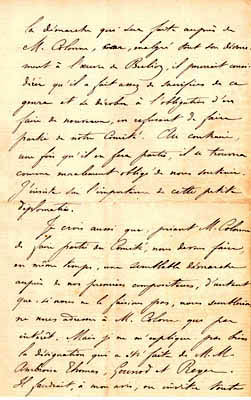
See the transcription of the original French text (the end of the letter is missing)
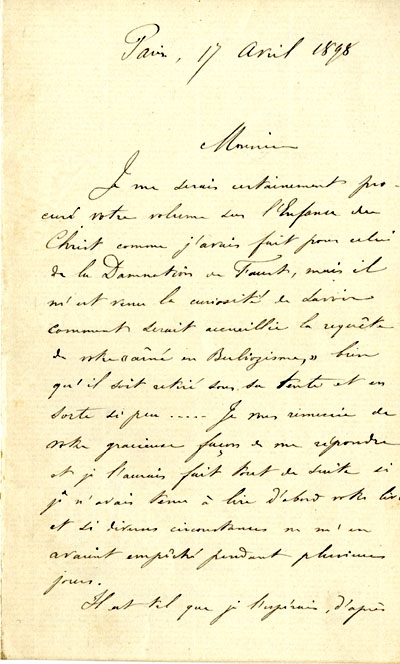
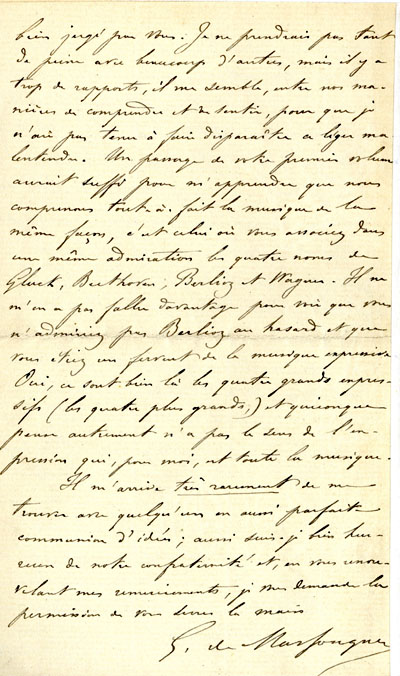
See the transcription of the original French text
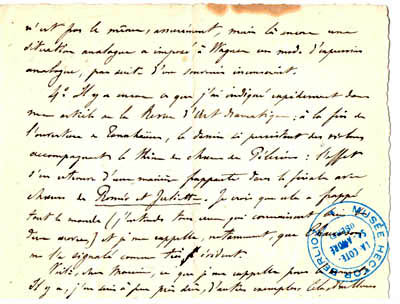
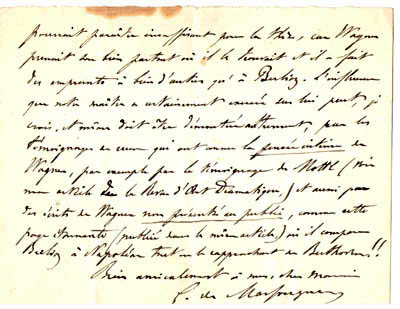
See the transcription of the original French text (the beginning of the letter is missing)
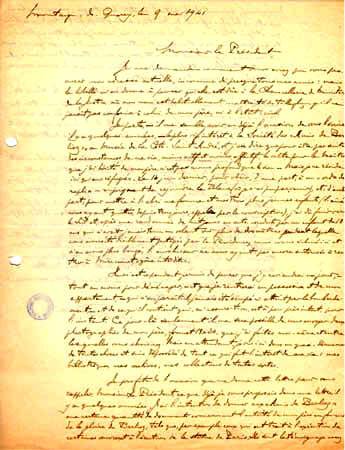
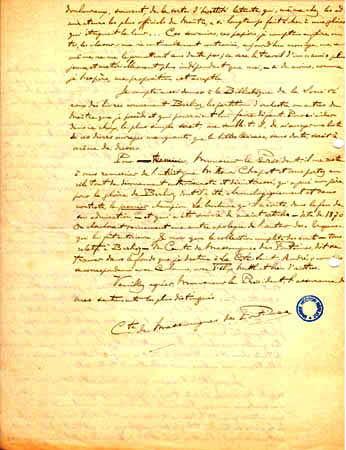
See the transcription of the original French text.
![]()
The Hector Berlioz Website was created by Monir
Tayeb and Michel Austin on 18 July 1997;
Page Berlioz: Pioneers and
Champions created on 15 March 2012; this page created on 1
October 2013, updated on 1 May 2018.
© Monir Tayeb and Michel Austin. All rights reserved.